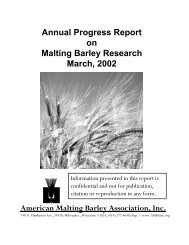Annual Progress Report on Malting Barley Research March, 2007
Annual Progress Report on Malting Barley Research March, 2007
Annual Progress Report on Malting Barley Research March, 2007
You also want an ePaper? Increase the reach of your titles
YUMPU automatically turns print PDFs into web optimized ePapers that Google loves.
Project Title: The Oreg<strong>on</strong> <strong>Barley</strong> Improvement Program<br />
<strong>Research</strong>ers: Dr. Patrick Hayes, Dr. Jennifer Kling, Dr. Peter Szucs, Ms. Ann<br />
Corey, Ms. Tanya Filichkin<br />
Department: Dept. of Crop and Soil Science<br />
Instituti<strong>on</strong>: Oreg<strong>on</strong> State University, Corvallis, OR 97331<br />
Executive Summary<br />
How the OSU program helps AMBA realize its missi<strong>on</strong> and primary objective: The<br />
two principal goals of this project remain (1) to develop six-row winter malting barley<br />
varieties that will assist AMBA in meeting its missi<strong>on</strong> of providing the malting and<br />
brewing industries with an abundant supply of high quality malting barley and (2) to<br />
develop molecular breeding tools that will benefit all barley breeders working to advance<br />
the AMBA cause. We are addressing AMBA’s primary objective – ensuring that barley<br />
is a competitive crop – by incorporating malting quality into high yielding winter habit<br />
varieties that provide growers with a profitable and productive cropping opti<strong>on</strong>.<br />
Major issues, soluti<strong>on</strong>s, and expected benefits: We have developed a winter barley<br />
germplasm base suitable for making the elite x elite crosses from which most malting<br />
barley varieties derive. It has taken 20 years to reach this point due to necessity of<br />
combining malting quality, disease resistance, and winter hardiness. Our approach to<br />
solving these complex issues has been to develop molecular breeding tools based <strong>on</strong><br />
knowledge of gene locati<strong>on</strong>s, effects, and interacti<strong>on</strong>s. We now have excellent parental<br />
stocks and two years ago embarked <strong>on</strong> a more extensive crossing program to generate<br />
the segregating generati<strong>on</strong> progeny from which AMBA-approved varieties can be<br />
expected to come. The benefits will be high yielding malting barley varieties that<br />
represent a new, dependable, and alternative source of high quality malting barley.<br />
One-year objectives and outcomes: We developed, tested, characterized, and<br />
selected winter germplasm at multiple locati<strong>on</strong>s. We have ceased all spring barely<br />
improvement efforts, except for specialized disease resistance stocks. We have<br />
advanced lines with excellent yields under irrigated and dryland c<strong>on</strong>diti<strong>on</strong>s. These high<br />
yielding lines have good disease resistance and potentially acceptable malt profiles. We<br />
have developed perfect markers for target traits and implemented these in our breeding<br />
program. No malting quality data are available for the 2006 crop samples, due to the<br />
c<strong>on</strong>structi<strong>on</strong> of a new facility for the CCRU.<br />
Most significant accomplishments: Per the preceding secti<strong>on</strong>, we have developed<br />
some very exciting germplasm and we have developed molecular breeding tools to<br />
accelerate future gains. Three lines are in their first year of AMBA Pilot Scale testing. A<br />
new line is in increase for submissi<strong>on</strong> to the program in <strong>2007</strong>. And the breeding pipeline<br />
is full.<br />
102
















